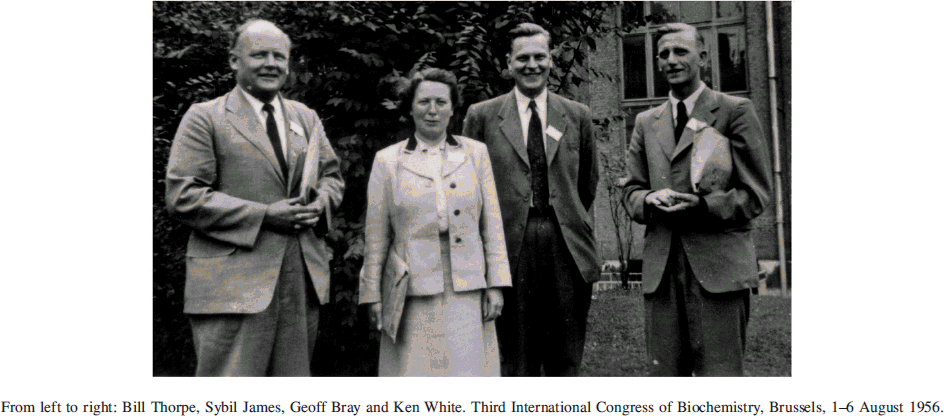
After gaining a first class degree in Chemistry from the University of Birmingham, Sybil studied for a PhD, working on the structure of complex carbohydrates (pectic acid, gum tragacanth, amino sugars) in the laboratory of WN Haworth, a noted chemist who had shared a Nobel prize (1937) for his work on Vitamin C. During World War 2 she joined a team assessing the nutritional consequences of food rationing, mainly with Geoffrey Bray and William Thorpe, and also others such as Magnus Pike. These essential wartime activities also served to mask secret work undertaken on the attempted separation of uranium isotopes via halogen derivatives (fluoride chemistry flourished at Birmingham). Bill Thorpe was running the previously formed sub-department of Physiological Chemistry with Geoff Bray when Sybil joined as a lecturer in 1946, and so began her long scientific career of research and teaching.
Just after the war, the sub-department had been asked to study the metabolism of anti-sprouting agents for potatoes, which were vital to increase the food supply. These were nitrochlorobenzenes and it was soon discovered that they combined with a compound called glutathione inside the potato. This finding sparked what was to be the key research theme of the next few decades. It became clear that many chemically reactive compounds linked with glutathione and were detoxified by this pathway, then broken down and excreted as derivatives called mercapturic acids. Systematic exploration of the classes of chemicals which reacted with glutathione, the development of [35S]-radio-labelling techniques to “follow” metabolites, the revealing of their biliary excretion and recycling and understanding the sequential steps leading to N-acetylcysteine conjugate formation eventually uncovered the complete pathway from glutathione to mercapturic acid that we take for granted today.
The sub-department was also firmly entrenched in teaching; the most important, but oft side-lined, role of a University. The paucity of texts on the emerging subject of biochemistry had prompted Bill Thorpe to compile a volume to accompany their sub-department’s new course in 1938; after the war, Sybil and Geoff Bray helped to develop this into the well-known, “Thorpe, Bray and James: Biochemistry for Medical Students”. Clear and definitive, it was translated into many languages and ran into many editions, the last one being in 1970. When the new journal, “Xenobiotica”, was founded by Dennis Parke as an outlet for the rising science of foreign compound metabolism, Sybil and the department supportively submitted two papers to the first edition and five during the first year (1971). During the 1970s, the need for more trained toxicologists was becoming apparent and Sybil designed and organised a Master’s programme, albeit requiring intense determination and persuasive diplomatic skills to circumvent the endless University bureaucracy. A crucial feature of the course was the considerable involvement of industrialists, both as lecturers and during many off-site visits, so that the students were able to interact and gain an understanding of their potential futures. The MSc in Toxicology started in 1979, proved very successful and is still running today. As a testament to Sybil, her ex-students, both MSc and PhD, are to be found in every part of the world, in academic life, research institutes and pharmaceutical industries.
This is only a sprinkling of a lifetime’s achievements, so valued by those who knew her. Sybil’s legacy, secured through her tireless effort, is the recognition of toxicology as a discipline in its own right. Her continuous stream of solid publications (earning her a DSc), produced against a background of family life and a heavy teaching load, is an inspiration to her successors. Most of all, though, those who were fortunate enough to be her students and friends will remember her kindness.
